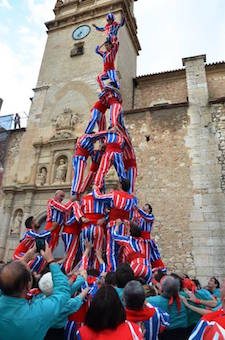
Els Tornejants d’Algemesí and La Muixeranga performance in Serenates have the particular feature of starting in the Cloister of La Nau, moving towards the Patriarca Square throughout their performance. It starts today Friday at 9pm and the entry is free. Furthermore, it is also part of July Fair programme, organised by Valencia’s City Hall in several places of the city.
La Muixeranga and Els Tornejants d’Algemesí are the two most emblematic dances of the Mare de Déu de Salut procession of Algemesí, which have been declared by UNESCO to be Intangible Cultural Heritage of Humanity.
Els Tornejants is a kind of war dance with chivalrous and mystical characteristics which proves the skills and abilities of a group of smartly dressed knights who play with the gravity to the rhythm of the kettledrum rough sounds. This dance, which is traced back to the 18th century (apparently to 1747), is the only one that is integrated within the religious part of the procession.
There are seven dancers performing different dances. The first of them is the page, who is in charge of sprinkling, with holy water, the ground on which the protected lady, Mare de Déu de la Salut, will walk. They are also included in the dance.
The dances can be performed by one, by two, four or six dancers, being the main ones: ‘floretes’, ‘sis puntes’, ‘Magos’ and ‘La fuga’ (the most representative one). Plus the following: 'Carreretes', 'Cadireta', 'Crussà' and 'Quatre cares'. ‘La Fuga’ is the longest and most beautiful dance, which has the following parts: paseo, torneo and cabriolas. It is performed by six dancers. It foreshadows a medieval tournament and it ends with a reverential genuflection.
More than three centuries of history and an important symbolic significance have made la Muixeranga the most known image of Algemesí. The first documented news of the dance dates back to Llibre de Comptes de la Vila in 1733, but it is thought to be much older.
The muixeranguers, dressed in a characteristic dress made of mattress fabric, evolve along the dolçaines and tabals music creating several traditional living pictures which culminates in the uprising of the well-known human towers.
Solemn and rhythmic, the sound of la Muixeranga has spread its symbolic significance beyond Algemesí, becoming cultural heritage of all Valencian people. It begins with the marked pace of tabals, when the base of the tower is shaped and does not stop until it completely disintegrates. Dolçaines begin to sound with the creation of the second floor of the tower and are repeated until it is concluded by the figure of a child on the top.
Last update: 8 de july de 2016 08:00.
News release



















